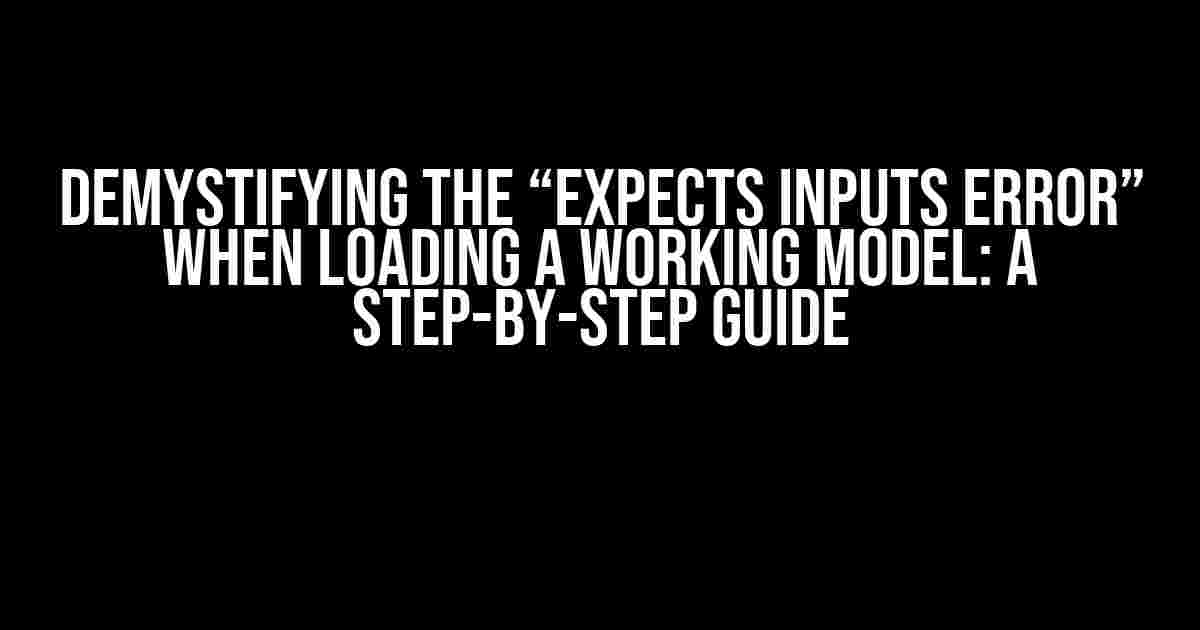Are you tired of encountering the frustrating “Expects Inputs Error” when trying to load a working model? You’re not alone! This error can be confusing, especially for those new to machine learning or model deployment. Fear not, dear reader, for we’re about to embark on a journey to resolve this issue once and for all.
What Causes the “Expects Inputs Error”?
The “Expects Inputs Error” typically occurs when there’s a mismatch between the model’s expected input format and the actual input provided. This discrepancy can arise from various sources, including:
- Incorrect input shape or size
- Missing or unnecessary input features
- Data type mismatches (e.g., float vs. integer)
- Incompatible model architectures
In this article, we’ll delve into the possible causes and provide actionable solutions to rectify the issue.
Step 1: Verify Model Input Requirements
The first step in resolving the “Expects Inputs Error” is to understand the model’s input requirements. This involves reviewing the model’s documentation, architecture, and code to identify the expected input format.
# Example code snippet to check model input shape
from tensorflow.keras.models import load_model
model = load_model('working_model.h5')
input_shape = model.input_shape
print(f"Expected input shape: {input_shape}")
In the above example, we load the working model using Keras and retrieve its input shape using the `input_shape` attribute.
Table 1: Model Input Requirements Checklist
| Requirement | Description |
|---|---|
| Input Shape | The expected shape of the input data (e.g., (batch_size, width, height, channels)) |
| Data Type | The expected data type of the input data (e.g., float32, int32) |
| Input Features | The required input features or columns (e.g., image pixels, categorical labels) |
Step 2: Prepare Input Data
Once you’ve identified the model’s input requirements, it’s essential to prepare the input data accordingly. This may involve:
- Reshaping the input data to match the expected shape
- Converting the input data to the required data type
- Ensuring the presence of necessary input features
# Example code snippet to prepare input data
import numpy as np
# Assume input_data is a NumPy array
input_data = np.array([[1, 2, 3], [4, 5, 6]])
# Reshape input data to match the expected shape
input_data = input_data.reshape((1, 2, 3))
# Convert input data to the required data type (float32)
input_data = input_data.astype('float32')
print(f"Prepared input data: {input_data}")
Step 3: Load the Working Model Correctly
Now that you’ve prepared the input data, it’s time to load the working model correctly. This might involve:
- Specifying the correct model architecture or configuration
- Loading the model with the correct input shape and data type
- Ensuring compatibility with the deployment environment
# Example code snippet to load the working model correctly
from tensorflow.keras.models import load_model
# Load the working model with the correct input shape and data type
model = load_model('working_model.h5', input_shape=(1, 2, 3), dtype='float32')
print(f"Loaded working model: {model}")
Step 4: Verify Model Input Compatibility
The final step is to verify that the loaded model is compatible with the prepared input data. You can do this by:
- Checking the model’s input shape and data type
- Performing a dry run to test the model’s input compatibility
# Example code snippet to verify model input compatibility
import numpy as np
# Prepare a sample input data
sample_input = np.random.rand(1, 2, 3).astype('float32')
# Perform a dry run to test the model's input compatibility
output = model.predict(sample_input)
print(f"Model output: {output}")
Conclusion
In this comprehensive guide, we’ve explored the “Expects Inputs Error” that occurs when loading a working model. By following the step-by-step instructions outlined above, you should be able to resolve the issue and successfully load your working model.
Remember to:
- Verify the model’s input requirements
- Prepare the input data accordingly
- Load the working model correctly
- Verify model input compatibility
By doing so, you’ll be well on your way to deploying your machine learning model with confidence. Happy modeling!
Frequently Asked Question
Get the answers to your “Expects Inputs Error when loading working model” questions and get back to working with your model in no time!
What is the “Expects Inputs Error” and why is it happening when I load my working model?
The “Expects Inputs Error” occurs when the input data or configuration does not match the expected format or structure required by the model. This can happen when you’ve made changes to your input data or the model’s architecture, causing a mismatch between the two. Fear not, it’s an easy fix! Check your input data and model architecture to ensure they’re compatible, and you’ll be back to modeling in no time!
How do I identify the root cause of the “Expects Inputs Error” in my working model?
To identify the root cause, review the error message carefully, as it usually provides a hint about the issue. Check your input data, model architecture, and configuration files for any inconsistencies or changes that might be causing the error. You can also try loading a previous version of your model or input data to see if the error persists. If you’re still stuck, try breaking down your model into smaller components to isolate the issue.
Can I still use my working model even with the “Expects Inputs Error”?
Unfortunately, no. The “Expects Inputs Error” means your model cannot function as intended until the issue is resolved. You’ll need to fix the input data or model architecture mismatch before you can continue working with your model. Don’t worry, it’s a common error, and with a little troubleshooting, you’ll be back to making predictions and insights in no time!
How do I prevent the “Expects Inputs Error” from happening in the future?
To prevent this error from occurring in the future, make sure to thoroughly test your input data and model architecture changes before loading your model. Use version control systems to track changes to your code and data, and have a backup plan in case things go awry. Additionally, consider implementing automated testing and validation pipelines to catch any potential errors before they become a problem.
Where can I get more help if I’m still struggling with the “Expects Inputs Error”?
Don’t worry, we’ve got you covered! If you’re still struggling to resolve the “Expects Inputs Error”, you can reach out to the community forums, documentation, or support teams for your specific modeling tool or platform. You can also search for online resources, tutorials, or blogs that provide troubleshooting guides and best practices for resolving this error. We’re all in this together!


